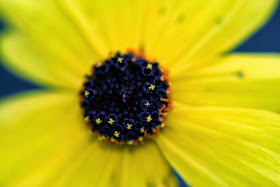This is a blog that celebrates the beauty and diversity of Florida's wildflowers - with a bit of a focus on growing these plants in a home landscape. Some of the wildflowers featured here are grown and sold through Hawthorn Hill Native Wildflower and Rare Plant Nursery. E-mail (Huegelc55@aol.com)or call me (727-422-6583) if there is something you want to see in this blog - or something you wish to purchase.
Sunday, October 20, 2013
Leavenworth's Tickseed - Coreopsis leavenworthii
There are few wildflowers that say "wildflower" better than Leavenworth's tickseed (Coreopsis leavenworthii). It is found statewide in a variety of habitats, is nearly endemic (found in a few locations in Georgia), and is essentially the wildflower adopted as the official state wildflower (though the state legislature selected the overall genus and the license tag depicts the non-native, C. basalis, which is a bit showier). Often, this species is simply referred to as "coreopsis" when a discussion centers on it and it is widely propagated in the native plant industry.
Leavenworth's tickseed is most frequently encountered in moist sites, but is very adaptable and can be found in a variety of upland areas as well. Though described as a perennial, I find it to behave more as an annual. If plants survive past their first year, they are extremely short-lived perennials. They proliferate profusely, however, by producing large numbers of seed. In a natural or home landscape setting, this often results in the plant forming extensive colonies.
Leavenworth's tickseed is a thin plant with narrow leaves and a narrow crown. In my garden, it emerges in early spring and quickly grows to a mature height of 18-24 inches. Many small flowers are produced at the ends of each branch from summer into fall, though it may bloom through the year in extreme south Florida. Each flower is about one inch across; the bright yellow ray petals surround a darker disc. Like all members of the aster family, these blooms are of great interest to pollinating insects.
Because of its adaptability, its ability to persist and thrive in most landscape settings, and its cheery blooms that occur for months before declining, Leavenworth's tickseed is an extremely popular wildflower for the home landscape. Ours has persisted for more than a decade in our landscape without any supplemental care. The only thing that keeps it in check are the cottontail rabbits that love to eat it and the occasional weeding I do to keep it in bounds. This is a widely propagated species and should be easy to locate from commercial sources. Do not deadhead spent blooms for at least a month after flowering has finished if you want this plant to reseed and persist, and because the seeds are small, do not mulch it too heavily.




I just found your blog while I was searching for information on liatris tenuifolia. I am looking forward to reading more of your blog! I live on the Gulf Coast of Alabama and have been noticing all of the beautiful wildflowers blooming and didn't know their names. Now I know where to turn. Thanks for sharing all of your knowledge on wildflowers. - Rachel
ReplyDeleteCoreopsis is beautiful and very easy for a Florida gardener to incorporate into a landscape. Thank you for the big pretty pictures, both close-ups and within the structure of your garden and the information!
ReplyDelete